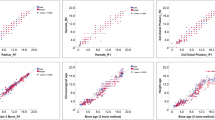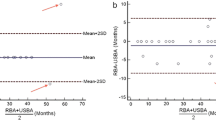Abstract
Bone age (BA) is usually estimated using the atlas of Greulich-Pyle (GP) or Tanner-Whitehouse (TW) and depends on the individual experience of the investigator. A computer-aided method, computer-assisted skeletal age scores (CASAS), based on the TW2-radius, ulna, short bones (RUS) method has been created to increase reliability and validity. We compared the results of the three different methods (CASAS, GP, TW2) in three groups of children with Turner's syndrome (TS), growth hormone deficiency (GHD), and familial short stature (FSS). The practicability and reliability of CASAS was investigated and the results compared with those obtained by the other methods. Each method was applied by one investigator, with up to six consecutive BA estimations per subject being carried out in 5 patients with TS, 6 with GHD and 18 with FSS. Using CASAS, individual bone evaluations had to be repeated once in 7.3% and twice in 2.7% of all probands on request of the computer system because of doubtful results. Manual interventions by the investigator were necessary in 12.3% of evaluations in TS, 8.5% in GHD and 9.0 in FSS. The frequency of a “warning” insert, indicating uncertainty of CASAS, was also higher in TS than in GHD and FSS (19.0% vs. 15.0 and 13.0%). The majority of external corrections for CASAS were necessary for evaluations of the fifth finger and the thumb. On three occasions with TS the progress of BA determined by CASAS demonstrated a regressive course with age. CASAS and manual TW2 BA data were comparable and generally higher than BA data obtained by GP (mean + 1.1 years). In conclusion, CASAS represents a useful method for analysing skeletal age and seems to increase reliability by rating on a continuous scale. However, difficulties with abnormally shaped bones restricts its use in some pathologic conditions.
Similar content being viewed by others
References
Greulich WW, Pyle SI (1959) Radiographic atlas of skeletal development of the hand and wrist, 2nd edn. Stanford University Press, Stanford, California
Tanner JM, Whitehouse RH, Marshall WA, Healy MIR, Goldstein H (1975) Assessment of skeletal maturity and prediction of adult height (TW2 method). Academic Press, New York
Beunen G, Cameron N (1980) The reproducibility of TW2 skeletal age assessments by a self-taught assessor. Ann Hum Biol 7: 155–162
Tanner JM, Gibbons RD (1994) A computerized image analysis system for estimating Tanner-Whitehouse 2 bone age. Horm Res 42: 282–287
Tanner JM, Oshman D, Lindgren G, Grunbaum JA, Elsouki R, Labarthe D (1994) Reliability and validity of computer-assisted estimates of Tanner-Whitehouse skeletal maturity (CASAS): comparison with the manual method. Horm Res 42: 288–294
Tanner JM, Landt KW, Cameron N, Carter BS, Patel J (1983) Prediction of adult height from height and bone age in childhood. A new system of equations (TW Mark II) based on a sample including very tall and very short children. Arch Dis Child 58: 767–776
Bayley N, Pinneau SR (1952) Tables for predicting adult height from skeletal age: revised for use with the Greulich-Pyle hand standards. J Pediatr 40: 423–41
Vignolo M, Milani S, DiBattista E, Naselli A, Mostert M, Aicardi G (1990) Modified Greulich-Pyle, Tanner-Whitehouse, and Roche-Wainer-Thissen (knee) methods for skeletal age assessment in a group of Italian children and adolescents. Eur J Pediatr 149: 314–317
Brämswig JH, Fasse M, Holthoff M-L, von Lengerke HJ, von Petrykowski W, Schellong G (1990) Adult height in boys and girls with untreated short stature and constitutional delay of growth and puberty: accuracy of five different methods of height prediction. J Pediatr 117: 886–891
Cameron N (1993) Assessment of growth and maturation during adolescence. Horm Res 39: 9–17
Carpenter CT, Lester EL (1993) Skeletal age determination in young children: analysis of three regions of the hand/wrist film. J Pediatr Orthop 13: 76–79
Beunen G, Lefevre J, Ostyn M, Renson R, Simons J, van Genen D (1990) Skeletal maturity in Belgian youths assessed by the Tanner-Whitehouse method (TW2). Ann Hum Biol 17: 355–376
Murata J (1995) Japanese specific bone age standards on the TW2 estimation method. Clin Pediatr Endocrinol (in press)
Zachmann M, Sobradillo B, Frank M, Frisch H, Prader A (1978) Bayley-Pinneau, Roche-Wainer-Thissen, and Tanner height predictions in normal children and in patients with various pathologic conditions J Pediatr 93: 749–755
Bergmann P, Valsamis J, van Perborgh J, de Schepper J, van Vliet G (1990) Comparative study of the changes in insulin-like growth factor-1, procollagen-III n-terminal extension peptide, bone gla-protein, and bone mineral content in children with Turner's syndrome treated with recombinant growth hormone. J Clin Endocrinol Metab 71: 1461–1467
Roche AF, Davila GH, Eyman SL (1971) A comparison between Greulich-Pyle and Tanner-Whitehouse assessments of skeletal maturity. Radiology 98: 273–280
Author information
Authors and Affiliations
Additional information
This paper is dedicated to Prof. Walter Swoboda on the occasion of his 80th birthday.
Rights and permissions
About this article
Cite this article
Frisch, H., Riedl, S. & Waldhor, T. Computer-aided estimation of skeletal age and comparison with bone age evaluations by the method of Greulich-Pyle and Tanner-Whitehouse. Pediatr Radiol 26, 226–231 (1996). https://doi.org/10.1007/BF01405306
Received:
Accepted:
Issue Date:
DOI: https://doi.org/10.1007/BF01405306




